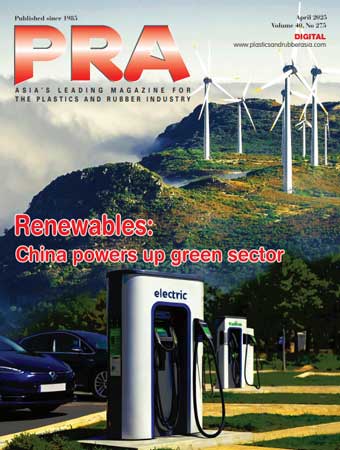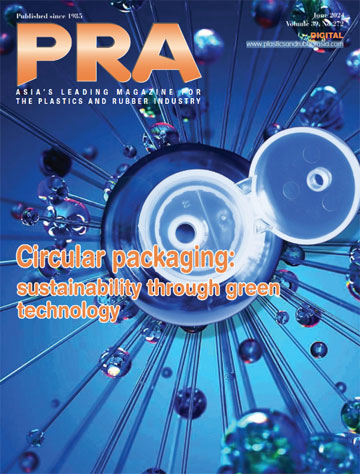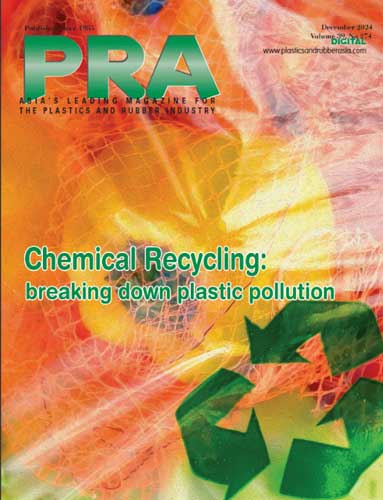Strong growth for bio-based polymers; Asia in the lead
The year 2024 was a “respectable” year for biobased polymers, with an overall expected CAGR of 13% to 2029, according to a new market and trend report “Bio based Building Blocks and Polymers – Global Capacities, Production and Trends 2024–2029”, written by Nova-Institute.
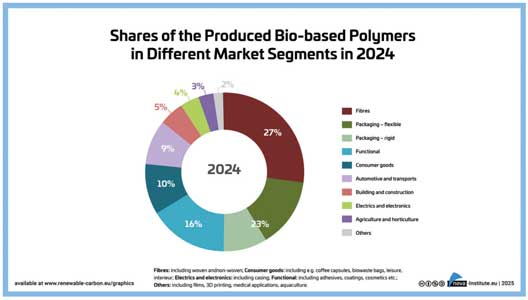
It adds that overall, bio-based biodegradable polymers have large installed capacities with an expected CAGR of 17% to 2029, but the current average capacity utilisation is moderate at 65%. In contrast, biobased non-biodegradable polymers have a much higher utilisation rate of 90%, but will only grow by 10% to 2029.
The report also highlights that while Asia and North America will continue to strengthen their global role in the supply of bio-based polymers, Europe's market share is expected to decline by 2029.
Types of resins
Of the total 4.2 million tonnes of bio-based polymers produced in 2024, cellulose acetate (CA), with a biobased content of 50%, and epoxy resins, with a biobased content of 45%, account for more than half of the bio-based production, 26% and 32%, respectively.
This is followed by 30% bio-based polyurethanes (PU) with 9%, 100% bio-based polylactic acid (PLA) with 8%, polyamides (PA) (60% bio-based content) with 7% and polytrimethylene terephthalate (PTT) (31% bio-based content) with 6%.
The share of aliphatic polycarbonates (APC; circular and linear), poly(butylene adipate-co-terephthalate) (PBAT), polyethylene (PE), polyethylene terephthalate (PET), polyhydroxyalkanoates (PHA) and starchcontaining polymer compounds (SCPC) was less than 5%.
Casein polymers (CP), ethylene propylene diene monomer rubber (EPDM), polybutylene succinate (PBS), polyethylene furanoate (PEF) and polypropylene (PP) accounted for less than 1% of the total bio-based polymer production volume and are not shown.
Additionally, the total production volume of bio based polymers has been 4.2 million tonnes in 2024, which is 1% of the total production volume of fossil based polymers, and the CAGR of bio-based polymers is, with 13%, significantly higher than the overall growth of polymers (2–3%). With these growth rates, the share of bio-based polymers will increase up to 2%.
The increase in production capacity from 2023 to 2024 is mainly due to the expansion of PLA capacity and epoxy resin production in Asia, as well as a global increase in PU production.
Also, PP, PHA and PEF are particularly expected to grow continuously by 65% on average until 2029. While PHA capacities will increase mainly in Asia and PEF in Asia and in Europe, PP capacities will increase mainly in North America.
Demand for bio-based feedstock and land use
Considering the steadily increasing demand for bio based polymers, the need for biomass feedstocks should be considered as an important factor. This is particularly true for the recurring debate on the use of food crops for the production of bio based polymer.
The total demand for biomass was 13.6 billion tonnes for feed, bioenergy, food, material use, biofuels as well as bio based polymers.
While the majority of biomass (56%) is used for feed production, only 0.023% is required for the production of bio-based polymers, thus resulting in a biomass feedstock demand of 3.2 million tonnes for the production of bio-based polymers and reflects a land use share of only 0.013%.
This is due to the fact that the main feedstocks used in the production of bio-based polymers are sugars (25%) and starch (20%), which are obtained from highyield crops such as sugar cane and maize, resulting in a high area efficiency.
In addition, the protein content of these crops is used not only for polymer production but also for animal feed, so only the corresponding part is allocated to polymer production. Glycerol (31%), a biogenic by-product of biodiesel production, is a biomass with only an indirect, passive land use. This glycerol is mainly used in the production of epoxy resins via epichlorohydrin as an intermediate.
The biomass used also included 12% from non edible plant oils, such as castor oil, 9% from cellulose (mainly used for CA) and 3% from edible plant oil.
Of the bio based polymers produced (fully and partially bio based), 2.2 million tonnes were actual bio based components of the polymers (52%), meaning that almost 1.6 times more feedstock was required than was actually incorporated into the final product. The 1.4 million tonnes (36%) of feedstock that did not end up in the product is due to the high number of conversion steps and the associated losses of feedstock and intermediates, as well as the formation of by products.
Global shift to renewable carbon to overcome challenges
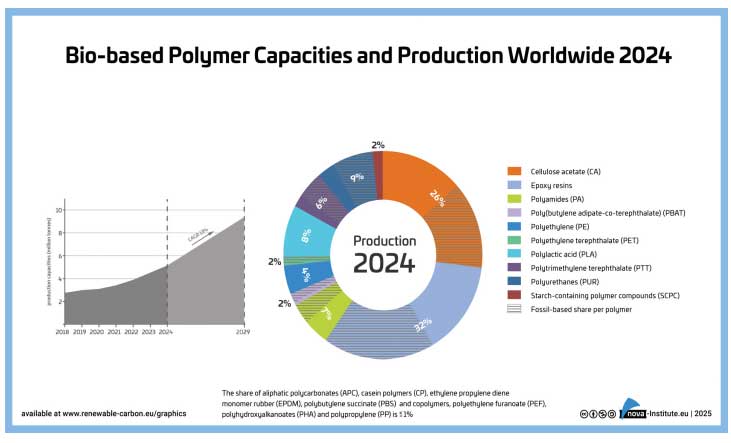
The key market drivers in 2024 were several global brands that have adapted their strategic agendas to transition the polymers, plastics and chemicals industry to become sustainable, climate-friendly and part of the circular economy, thus offering their customers green solutions and alternatives to petrochemical products.
The only way to achieve this successful transition is to fully replace fossil carbon with renewable carbon from alternative sources: biomass, CO2 and recycling (www.renewable-carbon.eu).
By expanding their feedstock portfolio to include renewable carbon in addition to fossil-based carbon, these brands are leading the way from a market perspective. In particular, the use of biomass has increased and will continue to increase the supply of bio-based polymers.
Nevertheless, the market remains challenging, especially in Europe. While Asia and North America will continue to strengthen their global role in the supply of bio-based polymers, Europe's market share is expected to decline by 2029.
With new investments in several large-scale biobased polymer production capacities, Asia and North America will increase their market share by 4% and 5%, respectively, and together they will account for more than 80% of the global supply of bio-based polymers. Although some new large-scale plants are also planned in Europe, this will not be enough to prevent Europe's market share from falling from 13% today to 10% in 2029.
Although, the European policy landscape for biobased polymers is constantly evolving, it does so not yet provide a consistent policy framework that sufficiently incentivises the benefits, properties and applications of bio-based polymers – unlike other regions of the world.
Highlights of bio-based polymers
The global polymer market includes functional and structural polymers, rubber products as well as man made fibres. This report focuses on the bio based share of the structural polymers.
Biobased structural polymers are composed of the polymers that will later form the structural mass of the finished plastic part, which is covered in detail in this report and the bio based linoleum part. Together, they total 4.3 million tonnes.
On the other hand, the total amount of bio based functional polymers consists of bio based functional polymers and paper starch, giving 13.7 million tonnes. In addition to these two groups, which account for 18 million tonnes of bio based functional and structural polymers, rubber products and man made fibres can also be bio based. In total, 15 million tonnes of rubber products and 7.8 million tonnes of man made fibres are made from bio based resources, 51% and 9%, respectively.
The different pathways of bio based “drop in”, “smart drop in” and “dedicated” inputs within the chemical production chain are also highlighted in the report. For each group, certain bio based polymers are presented as examples. In addition, biodegradable bio based polymers are highlighted with a green dot.
The different groups of bio based polymers are subject to different market dynamics. While drop ins have direct fossil based counterparts and can replace them, the dedicated ones have new properties and functionalities that are not available from petrochemicals. Both have their own advantages and disadvantages from a production and market perspective. While bio based drop in chemicals are bio based versions of existing petrochemicals that have established markets and are chemically identical to existing fossil based chemicals, smart drop in chemicals are a special sub group of drop in chemicals. Although they are chemically identical to existing chemicals based on fossil hydrocarbons, their bio based pathways offer significant process advantages over conventional pathways.
In addition, these bio based pathways can be based on completely new approaches, such as epichlorohydrin, where the fossil feedstock propylene is not replaced by bio based propylene but by glycerol from biodiesel production. Dedicated bio based chemicals are chemicals that are commercially produced via a dedicated pathway and do not have an identical fossil based counterpart.
Total installed capacity in 2024 was 5.2 million tonnes with an actual production of 4.2 million tonnes. Capacity is expected to increase to 9.5 million tonnes in 2029, indicating an average compound annual growth rate (CAGR) of around 13%. The following polymers show an even higher increase, well above the average growth rate: PP, PHAs and PEF are expected to grow continuously by an average of 65 % until 2029.
(PRA)SUBSCRIBE to Get the Latest Updates from PRA Click Here»

